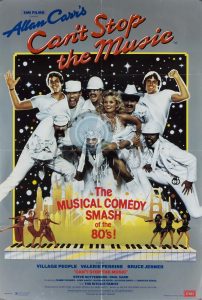
It was either this or “The Apple.” Those were the two choices given to me by fellow FAN columnist Justin Seals to review, his runner-up prize in a contest. I chose the Village People musical, as just last year I watched “The Apple” to cover as a guest on the See Hear podcast. Due to scheduling conflicts, I had to miss that recording (sending in a brief audio summation of my thoughts to be played after their review), but I digress. After watching “Can’t Stop the Music,” I wish I would’ve rewatched “The Apple” instead.
“Can’t Stop the Music,” which sounds like a cry for help as opposed to a statement, was released in 1980, a time when a penis could be seen in a PG-rated film and Hollywood experimented with Bruce Jenner as an actor. It was an awkward stage between the flash funk of the seventies and the rock and roll of the eighties, with the Village People caught in the middle. This would be a year prior to the release of the first ever music video, “Video Killed the Radio Star” by the Buggles. The Village People technically beat them to the punch, as this film is essentially one long music video stitched together within a narrative.
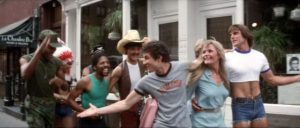
Jack Morrell (Steve Guttenberg) is an aspiring musician who’s looking to break into the business via a DJ gig at a New York club. After said gig goes successfully, his roommate, Samantha (Valerie Perrine), hooks him up with studio executives. She’s a retired model who has numerous connections, something this film relies on too heavily. The only problem Jack faces is his vocals; they’re not up to snuff. In comes the notorious Village People to save the day and I literally mean they come in almost out of thin air. The Indian (Felipe Rose) was at least shown as being a friend of theirs, but the rest just stumble onto the set. Their introduction consists of them wandering into frame as Samantha wanders through town looking for singers. It’s almost farcical.
The rest of the Village People consist of the Policeman (Ray Simpson), the Construction Worker (David Hodo), the Cowboy (Randy Jones), the Leatherman (Glenn Hughes), and the G.I. (Alex Briley). They have no distinct characteristics; they’re just walking costumes. They sing and dance well and the camera loves them, but engaging protagonists they are not. This is why Jack and Samantha are poised as the true protagonists, as they at least have a personality that isn’t defined by their wardrobe (despite Samantha being a model).
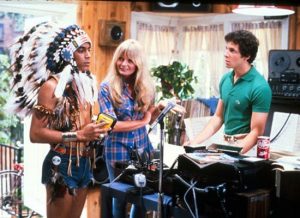
The Jack Morrell character could work in the hands of another actor. In Steve Guttenberg’s hands, it slips and falls. He plays the role as if he were in a parody of this film, hamming it up big time. The Village People themselves are more understated than his dopey performance! I suspect this was at the behest of the director, Nancy Walker, whose intention I presume was to show Jack as an innocent and fun-loving soul. What came across on screen was that of a man-child flailing about in between naps.
Samantha is more grounded and likable. She acts as the ringleader, reigning in the chaotic cartoonishness of the Village People’s quest for a record deal. She gets bogged down in two subplots that exist solely to pad out the film and act as plot convenience. The first is her love interest with Ron White (Bruce Jenner), a lawyer from St. Louis who falls for Sam because the script tells him to. The two have zero chemistry and Jenner is as stiff as a corpse and as lively as one. He’s the polar opposite of the goofy Steve Guttenberg. The other subplot consists of Sam’s former agent, Sydney Channing (Tammy Grimes), who tries valiantly to woo her former cash cow out of retirement.
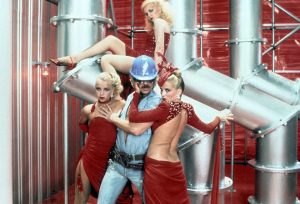
Sam is eventually wooed out of retirement out of mere plot convenience. When a record deal falls through, Sam uses a milk ad she’s been proposed as a way of exposure for the Village People. What follows is a fever dream of epic proportions, with the band dancing around provocatively whilst singing about milkshakes. I wonder if this was the inspiration for Paul Thomas Anderson’s famous scene from his masterpiece, “There Will Be Blood.”
The milkshake song is but one of many musical numbers scattered throughout “Can’t Stop the Music.” Others include “I Love You to Death,” “Liberation,” “Magic Night,” and the ever so popular “YMCA.” That last one feels the most like a music video, what with the Village People hopping around a YMCA, engaging in various activities such as swimming, showering, and gyrating. This could easily play on MTV a few years later if it weren’t for the quick flashes of penises.
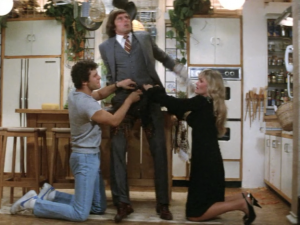
It’s fitting that Justin Seals’ two choices for me were “Can’t Stop the Music” and “The Apple,” as the two have a lot in common outside of being musicals released in 1980. Both are outrageously over-the-top productions that have a cult following. Both are ridiculed by many, with both of them being the inspiration for the Razzies. Yet, I actually enjoyed “The Apple.” It’s so bizarre that it’s a beguiling sight to behold! What made that film work was its outlandish storyline, with the protagonists rebelling against a cheesy corrupt government in futuristic year of 1994. It was a disco rock opera that utilized biblical tales such as Adam and Eve as its inspiration. It’s completely bonkers, yet it surprisingly works.
That’s what “Can’t Stop the Music” is missing: a story. The only one here is the Village People wanting to land a record deal and they do just that with relative ease. Even when they face setbacks, they shrug them off and joyfully start singing and dancing. There’s no drama to be had if our protagonists don’t care about the outcome of their story. The fact that the screenplay is credited to two people, Bronte Woodard & Allan Carr, astounds me! There’s not much here in the way of a plot, and what is here more strongly resembles that of the scribblings of a toddler.
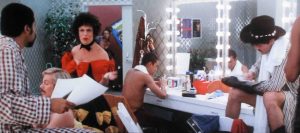
“Can’t Stop the Music” is as bizarre and outlandish as “The Apple,” but it’s too disjointed and aimless for it to work. It’s unabashedly energetic and is never boring, but never serves a purpose. Its only purpose is to play host to random musical numbers, albeit well-choreographed ones. The film is nothing more than an assault of camp and neon lights.
Final Rating: C-
